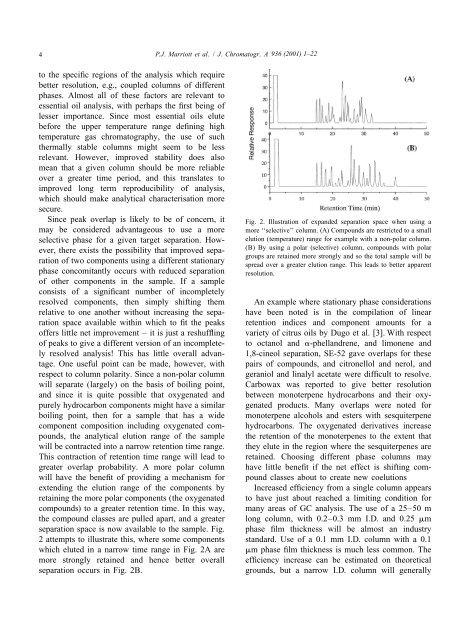Gas chromatographic technologies for the analysis of essential oils
Gas chromatographic technologies for the analysis of essential oils
Gas chromatographic technologies for the analysis of essential oils
Create successful ePaper yourself
Turn your PDF publications into a flip-book with our unique Google optimized e-Paper software.
4 P.J. Marriott et al. / J. Chromatogr. A 936 (2001) 1–22<br />
to <strong>the</strong> specific regions <strong>of</strong> <strong>the</strong> <strong>analysis</strong> which require<br />
better resolution, e.g., coupled columns <strong>of</strong> different<br />
phases. Almost all <strong>of</strong> <strong>the</strong>se factors are relevant to<br />
<strong>essential</strong> oil <strong>analysis</strong>, with perhaps <strong>the</strong> first being <strong>of</strong><br />
lesser importance. Since most <strong>essential</strong> <strong>oils</strong> elute<br />
be<strong>for</strong>e <strong>the</strong> upper temperature range defining high<br />
temperature gas chromatography, <strong>the</strong> use <strong>of</strong> such<br />
<strong>the</strong>rmally stable columns might seem to be less<br />
relevant. However, improved stability does also<br />
mean that a given column should be more reliable<br />
over a greater time period, and this translates to<br />
improved long term reproducibility <strong>of</strong> <strong>analysis</strong>,<br />
which should make analytical characterisation more<br />
secure.<br />
Since peak overlap is likely to be <strong>of</strong> concern, it<br />
may be considered advantageous to use a more<br />
selective phase <strong>for</strong> a given target separation. However,<br />
<strong>the</strong>re exists <strong>the</strong> possibility that improved sepa-<br />
ration <strong>of</strong> two components using a different stationary<br />
phase concomitantly occurs with reduced separation<br />
<strong>of</strong> o<strong>the</strong>r components in <strong>the</strong> sample. If a sample<br />
consists <strong>of</strong> a significant number <strong>of</strong> incompletely<br />
resolved components, <strong>the</strong>n simply shifting <strong>the</strong>m<br />
relative to one ano<strong>the</strong>r without increasing <strong>the</strong> separation<br />
space available within which to fit <strong>the</strong> peaks<br />
<strong>of</strong>fers little net improvement – it is just a reshuffling<br />
<strong>of</strong> peaks to give a different version <strong>of</strong> an incompletely<br />
resolved <strong>analysis</strong>! This has little overall advantage.<br />
One useful point can be made, however, with<br />
respect to column polarity. Since a non-polar column<br />
will separate (largely) on <strong>the</strong> basis <strong>of</strong> boiling point,<br />
and since it is quite possible that oxygenated and<br />
purely hydrocarbon components might have a similar<br />
boiling point, <strong>the</strong>n <strong>for</strong> a sample that has a wide<br />
component composition including oxygenated compounds,<br />
<strong>the</strong> analytical elution range <strong>of</strong> <strong>the</strong> sample<br />
will be contracted into a narrow retention time range.<br />
This contraction <strong>of</strong> retention time range will lead to<br />
greater overlap probability. A more polar column<br />
will have <strong>the</strong> benefit <strong>of</strong> providing a mechanism <strong>for</strong><br />
extending <strong>the</strong> elution range <strong>of</strong> <strong>the</strong> components by<br />
retaining <strong>the</strong> more polar components (<strong>the</strong> oxygenated<br />
compounds) to a greater retention time. In this way,<br />
<strong>the</strong> compound classes are pulled apart, and a greater<br />
separation space is now available to <strong>the</strong> sample. Fig.<br />
Fig. 2. Illustration <strong>of</strong> expanded separation space when using a<br />
more ‘‘selective’’ column. (A) Compounds are restricted to a small<br />
elution (temperature) range <strong>for</strong> example with a non-polar column.<br />
(B) By using a polar (selective) column, compounds with polar<br />
groups are retained more strongly and so <strong>the</strong> total sample will be<br />
spread over a greater elution range. This leads to better apparent<br />
resolution.<br />
An example where stationary phase considerations<br />
have been noted is in <strong>the</strong> compilation <strong>of</strong> linear<br />
retention indices and component amounts <strong>for</strong> a<br />
variety <strong>of</strong> citrus <strong>oils</strong> by Dugo et al. [3]. With respect<br />
to octanol and a-phellandrene, and limonene and<br />
1,8-cineol separation, SE-52 gave overlaps <strong>for</strong> <strong>the</strong>se<br />
pairs <strong>of</strong> compounds, and citronellol and nerol, and<br />
geraniol and linalyl acetate were difficult to resolve.<br />
Carbowax was reported to give better resolution<br />
between monoterpene hydrocarbons and <strong>the</strong>ir oxy-<br />
genated products. Many overlaps were noted <strong>for</strong><br />
monoterpene alcohols and esters with sesquiterpene<br />
hydrocarbons. The oxygenated derivatives increase<br />
<strong>the</strong> retention <strong>of</strong> <strong>the</strong> monoterpenes to <strong>the</strong> extent that<br />
<strong>the</strong>y elute in <strong>the</strong> region where <strong>the</strong> sesquiterpenes are<br />
retained. Choosing different phase columns may<br />
have little benefit if <strong>the</strong> net effect is shifting com-<br />
pound classes about to create new coelutions<br />
Increased efficiency from a single column appears<br />
to have just about reached a limiting condition <strong>for</strong><br />
many areas <strong>of</strong> GC <strong>analysis</strong>. The use <strong>of</strong> a 25–50 m<br />
long column, with 0.2–0.3 mm I.D. and 0.25 mm<br />
phase film thickness will be almost an industry<br />
2 attempts to illustrate this, where some components standard. Use <strong>of</strong> a 0.1 mm I.D. column with a 0.1<br />
which eluted in a narrow time range in Fig. 2A are mm phase film thickness is much less common. The<br />
more strongly retained and hence better overall efficiency increase can be estimated on <strong>the</strong>oretical<br />
separation occurs in Fig. 2B.<br />
grounds, but a narrow I.D. column will generally











![Bericht von Schimmel & Co. [Inhaber Gebr. Fritzsche] in Leipzig](https://img.yumpu.com/24438150/1/171x260/bericht-von-schimmel-co-inhaber-gebr-fritzsche-in-leipzig.jpg?quality=85)




